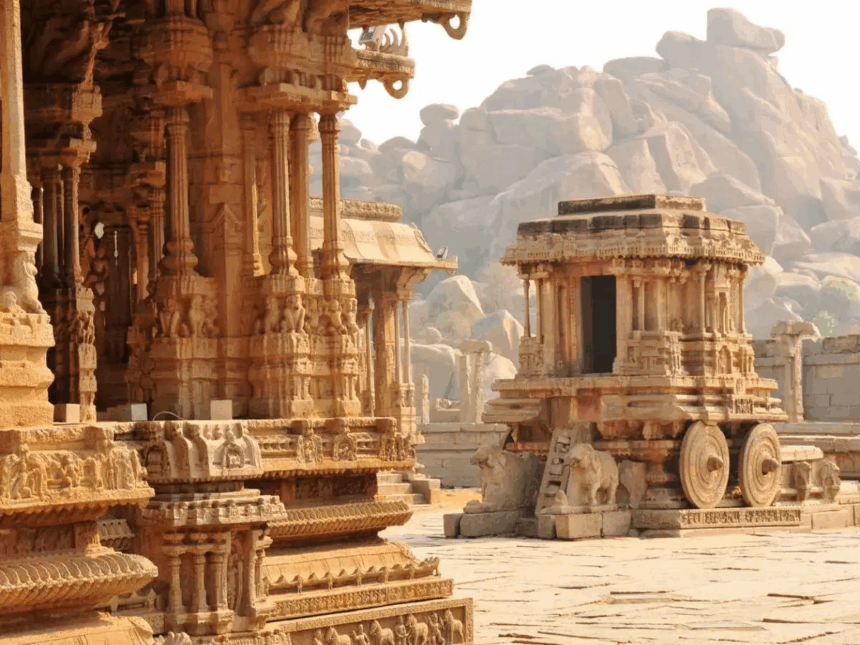South India holds some of the subcontinent’s most enduring architectural legacies. From the rock-cut marvels of Mahabalipuram to the grandeur of Chola temples, every site carries the memory of dynasties, devotion, and deep-rooted artistry. While many are familiar with a few key destinations, a broader itinerary reveals much more. Here is a refined selection of eight places that offer a balanced view of religious architecture, artistic excellence, and historical continuity.
1. Hampi, Karnataka
Picture Courtesy- Incredible India.gov
The ancient city of Hampi, once the capital of the Vijayanagara Empire, is now a UNESCO World Heritage site that stretches across a surreal landscape of boulders and riverbanks. Its many temples, including the towering Virupaksha Temple and the intricately carved Vittala Temple with its stone chariot, speak of a period when art and empire walked hand in hand. The remains of royal complexes, marketplaces, and pavilions evoke a once-thriving metropolis built with remarkable urban foresight.
2. Mahabalipuram, Tamil Nadu
Picture Courtesy- Incredible India.gov
Positioned along the Coromandel Coast, Mahabalipuram offers a striking collection of Pallava architecture. The Shore Temple, among the earliest structural temples in South India, rises against the backdrop of the Bay of Bengal. The monolithic rathas and the sculpted narrative panel known as Arjuna’s Penance display an early mastery in storytelling through stone. The site continues to influence architectural education and practice through its clarity of form and function.
3. Brihadeeswara Temple, Thanjavur
Picture Courtesy- Ramyas Hotel
Commissioned by Raja Raja Chola in the eleventh century, the Brihadeeswara Temple is among the most significant contributions of the Chola dynasty. The central vimana, rising over sixty metres, is built from granite and stands as an engineering accomplishment, especially given the region’s absence of native stone.
Picture Courtesy- Shuttershock
Intricate frescoes and inscriptions provide insight into the religious, cultural, and administrative systems of the time.
4. Gangaikonda Cholapuram, Tamil Nadu
Picture Courtesy- Indian Panorama
Built to commemorate Rajendra Chola’s victorious expedition to the Ganges, this temple mirrors the grandeur of Thanjavur but introduces a more refined sculptural language. The sanctum and its circumambulatory path retain a sense of ritual precision, while the outer wall carvings show deities rendered with grace and balance. Though less visited than its Thanjavur counterpart, it rewards those seeking detail over spectacle.
5. Pattadakal, Karnataka
Picture Courtesy- Conde Nast Traveller
A convergence of northern and southern architectural styles, Pattadakal served as a ceremonial site for coronations during the Chalukya reign. The group of temples here, especially the Virupaksha and Mallikarjuna Temples, exhibit artistic unity despite stylistic variation. The site offers valuable insights into temple architecture during a period of experimentation and formal transition.
6. Badami, Karnataka
Picture Courtesy- Viki Pandit
Surrounded by red sandstone cliffs, Badami features cave temples carved directly into the rock face. These caves represent Shaivism, Vaishnavism, and Jainism, demonstrating the region’s religious plurality. The sculptural reliefs inside, especially the depiction of Nataraja with multiple arms in rhythmic motion, reveal a sophisticated understanding of anatomy and movement.
7. Meenakshi Temple, Madurai
Picture Courtesy- The Times of India
Though parts of the Meenakshi Temple date back to the early centuries, its current form emerged under the Nayak rulers. This sprawling complex features tall gopurams that are densely packed with mythological figures and iconographic layers. The thousand-pillared hall, with its elaborate columns and ceiling frescoes, creates a space where ritual, commerce, and performance converge seamlessly within a sacred setting.
8. Lepakshi, Andhra Pradesh
Picture Courtesy- Xplro
Lepakshi’s Veerabhadra Temple is a gem of Vijayanagara craftsmanship. Located slightly off major tourist circuits, it contains some of the finest mural paintings in South India. The hanging pillar, an architectural anomaly that does not rest on the ground, continues to intrigue visitors. The open-air Nagalinga and sprawling monolithic structures contribute to its distinctive character.
These eight heritage destinations form a significant part of South India’s architectural and cultural identity. They vary in scale and location, yet all contribute to the region’s layered historical narrative. Visiting them is not merely about admiration of structure but about engaging with how history, art, and faith have shaped lived environments.

Ar. Pranjali Gandhare
Architect | Architectural Journalist | Historian








